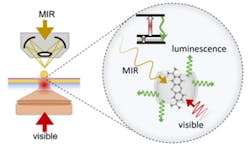Quantum system detects mid-infrared light at room temperature
A team of scientists from the University of Birmingham and the University of Cambridge is tapping quantum systems to convert low-energy invisible mid-infrared (MIR) photons into high-energy visible photons via molecular emitters. The approach shows potential to help scientists detect MIR and perform spectroscopy at a single-molecule level at room temperature.
The team’s work is based on MIR vibrationally assisted luminescence (MIRVAL), which involves quantum systems that can harvest both vibrational and electronic states of molecules (see figure and video).
“Vibrational states absorb MIR light, while electronic states absorb visible light,” explains Rohit Chikkaraddy, an assistant physics professor at the University of Birmingham. “When the system is exposed to visible light with energy below the absorption gap, we see no luminescence.”
When the system is exposed to MIR light, the combination of visible and MIR light is sufficient for excitation to happen—and it produces visible luminescence. This allows the scientists to upconvert the low-energy MIR light to visible light and enables the detection of MIR via silicon cameras like the ones used in smartphones today.
“We can now see the vibrational behavior of individual molecules at MIR wavelengths, which wasn’t possible before,” Chikkaraddy says.
The inspiration behind the team’s work stems from Chikkaraddy’s desire to explore lipid membrane dynamics, particularly how they interact with proteins within cells, because these processes are vital for cellular functions.
“Vibrations of individual lipid molecules, which control their behavior, occur within the MIR range,” Chikkaraddy says. “There were no suitable detection methods to see these vibrations at the detail of an individual lipid molecule, so there was a necessity to develop new methods to help us understand such functionalities at the molecular level.”
How does MIRVAL work?
The short answer: Bonds that maintain the distance between atoms in molecules “can vibrate like strings, and these vibrations resonate at very high frequencies,” Chikkaraddy says. “These springs can be excited by MIR-region light invisible to the human eye.”
At room temperature, these springs are in random motion, which means a major challenge in detecting MIR light is avoiding this thermal noise. Modern detectors rely on cooled semiconductor devices that are both energy-intensive and bulky, but the team’s work presents a new way to detect this light at room temperature.
Their MIRVAL method uses molecules that can be both MIR and visible light. For its design, Chikkaraddy and his team assembled molecular emitters into a tiny plasmonic cavity resonant in both the MIR and visible ranges. Further, they engineered the devices so the molecular vibrational and electronic states interact—which results in the efficient transduction of MIR light into enhanced visible luminescence.
The most difficult aspect of this work was “bringing together three widely different length scales—the visible wavelength (hundreds of nanometers), molecular vibrations (less than a nanometer), and mid-infrared wavelengths (10,000 nanometers)—into a single platform and to combine them efficiently,” says Chikkaraddy.
By creating picocavities, which trap light and are formed by single-atom defects on metallic facets, the team achieved extreme light confinement volume below one cubic nanometer—and confined MIR light down to the scale of a single molecule.
It came as quite a surprise to the researchers that their method works even at room temperature. “Vibrations are typically hugely affected by thermal noise, so it was very exciting to discover our MIRVAL process gives signal above the thermal noise,” Chikkaraddy says.
Better understanding of complex systems
The team’s work helps deepen our understanding of complex systems and opens the door to exploring infrared-active molecular vibrations, which tend to be inaccessible at the single-molecule level.
MIRVAL may find applications in real-time gas sensing, medical diagnostics, astronomical surveys, and quantum communication, “because we can see the vibrational fingerprint of individual molecules at MIR frequencies,” says Chikkaraddy. “The ability to detect MIR at room temperature means that it’s much easier to explore these applications and conduct further research within this field.”
MIRVAL also has a role to play not only in practical devices that will shape the future of MIR technologies, but also “in unlocking the ability to coherently manipulate the intricate interplay of ‘balls with springs’ atoms in molecular quantum systems,” Chikkaraddy says.
Chikkaraddy and colleagues now want to apply their technique to more complex systems like biological entities, such as lipid membranes, “so we can watch life in this new spectrographic window,” he adds.
FURTHER READING
R. Chikkaraddy et al., Nat. Photon. (2023); https://doi.org/10.1038/s41566-023-01263-4.
About the Author
Sally Cole Johnson
Editor in Chief
Sally Cole Johnson, Laser Focus World’s editor in chief, is a science and technology journalist who specializes in physics and semiconductors.

